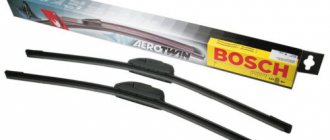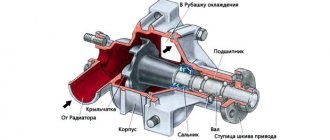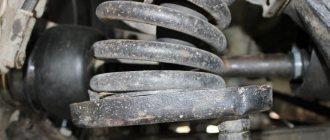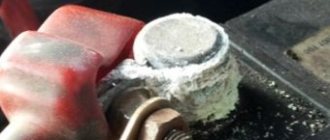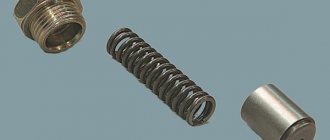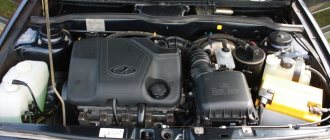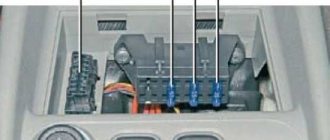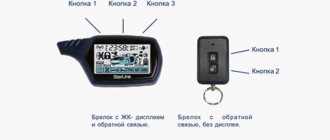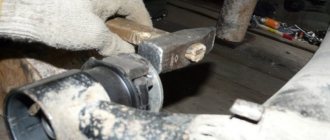Battery removal procedure
It is important to remember how to properly remove the terminals from the battery. There is a certain order of actions that must be followed. At the same time, do not forget about safety precautions. The sequence of actions is as follows:
- First you need to turn off the car.
- Turn off all electronic devices.
- Close windows and doors: if the car has power windows, after removing the battery, the windows will not be able to be raised. The doors will have to be closed manually with a key.
- Remove the cover protecting the battery terminals from dust and dirt.
- If there is no cover, you need to insulate the positive terminal with electrical tape.
- Remove grounding, if present.
- Loosen the nuts with a wrench.
- Disconnect the negative terminal, then the positive one.
- Do not allow the positive terminal to come into contact with metal objects.
An important technical point: it is the negative that needs to be disconnected first, so that a short circuit does not occur.
The car body, also called the ground, is connected to the negative terminal. When it is removed, the circuit is broken and a short circuit cannot occur, since the battery is disconnected from the body.
We recommend: Carrying out CTC of an acid battery at home
Thus, removing the terminal from the battery is easy. You just need to strictly follow the sequence of actions .
Next, you should take the necessary actions: recharge the battery or replace it with a new one.
Electronics setup
After the battery is connected, you need to adjust the on-board electronics, since after removing the battery all the settings were lost. For most cars the sequence of actions is as follows:
- Start the engine and warm it up.
- Turn off the car.
- Remove the negative terminal and wait two minutes.
- Put it back.
- Do the same with the positive terminal.
- Start the car again and let it idle for 15 minutes.
- Turn off the ignition, all data will be saved.
- Restart the car and test all electronic systems.
- Turn off the ignition and wait until the system records all parameters.
As a result, all on-board settings will be restored . This sequence of actions is suitable for all machines, regardless of brand.
Thus, in the process of installing and removing the battery, the main thing is not to confuse the sequence of actions, then a short circuit will not occur. If you learn how to restore the on-board settings of a car, you will master the full control of a modern car.
Required Tools
In order to connect and disconnect the battery on a car, you need the tools that are presented in the table below.
Table - Tools required to connect and disconnect the battery
| Tools | Note |
| Set of heads | Sizes from “10” to “18” depending on the machine model and terminal type |
| Ratchet | With extension |
| open-end wrench | For unscrewing and tightening terminal fasteners if it is impossible to reach with the head |
| Screwdriver | With straight or cross blade. Necessary for disconnecting some types of terminals |
| Brush | For cleaning dirt and oxidation |
| Sandpaper | For stripping terminals |
We recommend: Instructions for beginners on driving a car with an automatic transmission
Disconnecting and connecting battery terminals rarely leads to injury. Despite this, the battery is a chemical source of electricity and poses a certain danger. When working with it, there is a risk of contact with acid from the electrolyte. The voltage at the terminals is usually 12 V, but even this can lead to electrical injury under unfavorable conditions. Therefore, many car owners use protective equipment such as gloves and goggles for reinsurance.
How to remove a battery with stuck terminals
It often happens that the terminals or one of them become oxidized (covered with a white coating). In this case, they must be cleaned with a brush before removal. It should be quite rigid, but not iron. In case of strong sticking, it is better to use a contact cleaner (ABRO, LIQUI MOLY), they are sold in all car dealerships. If there is no special product, you can simply clean the contacts and use WD 40 lubricant. The process looks like this:
- Treat the terminals with solvent.
- Carefully hook the bottom of the terminal with a screwdriver and wiggle it.
- Try to twist the terminals in different directions until you can remove them.
It is important to use minimal force during the process, otherwise the battery contacts may be damaged.
Important! Some owners tap the oxidized terminals with a heavy object to remove them. This should not be done under any circumstances. Due to such actions, the terminals may permanently fail or fall apart into small pieces.
What to do to prevent the terminals from sticking
To avoid sticking, the terminals should be treated with a protective agent. Of the modern compositions, the most popular are:
- Molykote HSC Plus is a product of high electrical conductivity, operating at temperatures from -30 to +1100 o C;
- "Ciatim" - has good electrical conductivity characteristics at a low cost;
- German spray lubricant Liqui-Moly - protects well from oxidation and promotes stable voltage supply.
Drivers who prefer time-tested products opt for Litol or Negrol formulations. A mixture of grease and graphite lubricant also helps a lot.
Possible problems when removing the battery
When removing the battery, the owner runs the risk of encountering some problems. Their specifics depend on the equipment of the machine. For example, there are nuances for cars with a radio, alarm and on-board computer.
Signaling
For some car alarm models, power failure is associated with theft, so an alarm may sound. In addition, such alarms can block the doors at any time. Therefore, before removing the battery, the autonomous power supply of the alarm must be turned off. This is done with special keys that come with the alarm system.
You should first make sure that the car keys are in your pocket and not inserted into the ignition. It is better to leave one of the doors open, since when the battery is removed, the information from the alarm key fob may be erased.
Important! After returning the battery to its usual place, you need to check the alarm. After all, during the removal process, the settings that are responsible for the automatic activation or sensitivity of the alarm could have gone wrong.
Radio/cassette player
Most radios do not have their own power source, and when the battery is disconnected, the settings are most often lost. Therefore, after returning the battery to its place, you will have to re-tune the radio stations.
Important! Modern radios require a PIN code after switching on (a function that allows you to protect the device from theft). Therefore, before removing the battery, the owner should make sure that he knows the PIN code for his radio.
On-board computer
The on-board computer is responsible for the operation of all the electronics of a modern car. Usually it has separate power supplies where the most important settings are hidden, but their resource may be exhausted. In this case, the computer begins to be powered from the common system.
Some cars may have several on-board systems (for example, the Volkswagen Faeton has 6). After removing the battery, they all turn off and important settings are lost. To avoid unnecessary problems, in this case it is better to contact a service station to remove the battery.
Removing the battery is a procedure that must be approached responsibly and seriously. If you follow the instructions, you can avoid a lot of troubles, from a harmless failure of the settings in the radio to significant damage to the electronics and the battery itself.
If the terminals are oxidized
Oxidation at the terminal terminals occurs:
- due to a leaky battery case;
- due to a faulty generator giving overcharge.
The oxide forms in the form of a whitish coating, similar to salt, which indicates that it is urgent to take some measures to eliminate this defect. If plaque has accumulated on the battery terminals, it will not be easy to remove the wires from them, and before unscrewing the nuts and bolts, you must first remove the formed oxide.
The easiest way to clean the battery from plaque is with a baking soda solution; it must be applied to the oxidized surface and wait for a while. After the build-up has dissolved, its remnants will need to be thoroughly removed using a clean rag, and only then can you begin to remove the wires.
We recommend: Double clutch: the combination of advantages of manual and automatic
Another important point is that oxidized deposits accumulate on the inner surface of the battery cable terminals. It must be cleaned, otherwise contact is lost, the engine starts with problems, and the wires get hot.
You can clean oxidized areas using:
- sandpaper;
- WD-40;
- ordinary water and rags.
By the way, with a cloth moistened with water, the plaque can be cleaned effectively; you just need to spare the liquid and repeat the action several times. On the contrary, it is better not to use a metal brush - deep scratches form on soft metal, in which dirt accumulates, causing contact to deteriorate.
Types of terminals
There are different types of car battery terminals. Classified according to the following criteria:
By battery polarity
The pin locations can vary greatly. 2 terminals for the battery are connected to the power source - negative (-) and positive (+).
With direct polarity (Type “1”), the “positive” electrode is provided on the left, and the “minus” electrode on the right. This arrangement of contacts is often used in cars of domestic manufacturers. With reverse polarity (Type “0” and “5”) the electrodes are exactly the opposite. This placement method is used in car batteries from foreign companies.
The battery terminals can be connected diagonally relative to each other (Type “2”), located only on the right side of the battery (Type “3” and “4”).
According to the installation diagram
The terminals for connecting the battery may be located in different parts of the power source. There are 2 main options. In cars from Europe and Asia, electrical products are connected to terminals on the top edge of the housing. This is a common installation option, which is also used in Russian cars.
Please note that the American layout assumes that the electrodes are located on the side surface of the battery. Batteries for US vehicles cannot be installed in vehicles manufactured in Europe or Asia. Standard terminals on the battery simply will not allow connection.
According to the shape and overall dimensions of the terminals
The terminal pinouts for different power supplies can vary greatly. You need to pay attention to this before purchasing a battery, otherwise you may encounter insoluble problems when connecting the battery.
The terminal on Russian-made and foreign-made batteries has a cone-shaped terminal. In this case, the “positive” contact is larger in diameter compared to the “ground”. Some batteries have bolt terminals (for truck mounting) or screw terminals (North American standard).
By diameter, cone-shaped contacts are divided into regular (19.5 and 17.8 mm) and reduced (12.7 and 11.1 mm) for Japanese cars. In both cases, the negative terminal should be smaller in size than the positive terminal.
There are 2 options to solve the problem due to size mismatch. You can replace the output contacts or buy adapter battery terminals.
According to the material of manufacture
Lead. The best battery terminals for price-performance ratio. They are distinguished by increased mechanical strength. Despite its lower electrical conductivity than copper and brass, many manufacturers use this metal.
Lead is a material with a low melting point, which is a disadvantage of the metal. However, the lead contact will act as a fuse, which will melt due to short-term exposure to high temperatures in the event of a short circuit.
To improve performance and slow down oxidation processes, battery terminals are supplied with oxidized bolts and brass wings.
Copper. More expensive products. Copper battery terminals are rarely used in battery production. The main problem is the complex manufacturing technology. Compared with conventional lead electrical products, casting copper blanks is a labor-intensive process.
But copper has good physical and chemical characteristics: an excellent conductor of electricity. After installing copper terminals, winter starting of the engine will be simplified, the rate of contact oxidation will be reduced and battery charging will be accelerated.
Do not confuse copper and copper-plated steel terminals. The former are of better quality than the latter and have higher consumer properties. Many cheap adapter terminals are made of steel and coated with a layer of copper.
Brass . They are resistant to humidity and easy to perform installation and dismantling operations. Brass battery terminals are equipped with a wing nut and bolt, which oxidize very slowly. In this case, it is necessary to carefully install electrical products made of brass. The material is plastic and deforms when tightened too tightly with simple pliers.
Bronze. These are good battery terminals with high mechanical strength. Otherwise they are similar to brass electrical products.
Connecting the battery to the car
Immediately before installing the battery, it is necessary to clean the terminals with a brush. If dirt has formed on the surface of the battery, it must be removed with distilled water. Plain water cannot be used, as it may cause plaque to form.
Connect the battery in strictly reverse order:
- Place the battery in its original place.
- Tighten the fastener.
- Attach the “plus” terminal.
- Tighten the nuts with a wrench so that the structure fits tightly to the battery.
- Only after this connect the minus.
- Which terminal to remove first is “minus”. When connecting the battery back, connect the “plus” first.
Is it possible to disconnect one battery terminal when storing a car for a long time?
When leaving a car for long-term storage, it is customary to remove both terminals from the battery. This is due to the fact that during idle time the battery may simply discharge. Even when idle, the battery capacity is constantly decreasing as various electronic systems are powered: alarms, satellite systems, radars and more. Also, we must not forget about the self-discharge of the battery, which depends on the manufacturing technology of the device.
When parking the car for a long period of time, it is recommended to remove both terminals from the battery. By turning off only the “minus”, leakage currents will remain in the network. When only the “plus” is turned off, there is a high risk of an involuntary circuit closure, which threatens damage to the devices and fire of the car.
( 54 votes, average: 4.65 out of 5)
How to store a battery in winter? Do I need to remove the battery from my car in winter?
Pros and cons of gel car batteries
Related Posts
Installing the battery in the car
The reverse procedure, namely, the correct connection of the battery to the car after work has been completed or if it is replaced with a new unit, also requires compliance with the regulations. The first thing that the work contractor should take into account when installing the battery in a standard seat is its polarity: it is important to place the battery correctly in the car so that the positive “side” of the battery corresponds to the positive wire. It is worth noting that it will not be possible to connect the battery if it is installed inappropriately, since the negative terminal is much smaller than the positive docking mechanism; however, incorrect initial installation is an unnecessary and irrational waste of precious time and effort.
After installing the battery, it is important to securely fix it with standard fasteners, which will eliminate the possibility of damage to the battery during operation of the vehicle, when making sudden maneuvers or overcoming sections of roads with uneven surfaces.
Then all that remains is to figure out how to connect the battery to the car, namely, in what sequence to correctly place the terminals on the battery contacts so as not to cause a short circuit in the wiring, and to complete the battery installation process correctly. It would be correct to initially place the “positive” terminal on the corresponding battery contact, and tighten it tightly with a fastening nut, and only after that connect the negative terminal in the same way. At this point, the technical work on replacing the battery on the car can be considered completed; all that remains is to restore the on-board settings of the car.
And one more tip: before connecting the terminals, it is correct to lubricate their contact surfaces with an anti-corrosion substance or oil intended for processing electrical connections. The procedure is necessary to eliminate the possibility of deposits appearing on surfaces, and to facilitate the removal of terminals if there is a repeated need to replace or remove the battery before servicing the battery or vehicle in the future.
